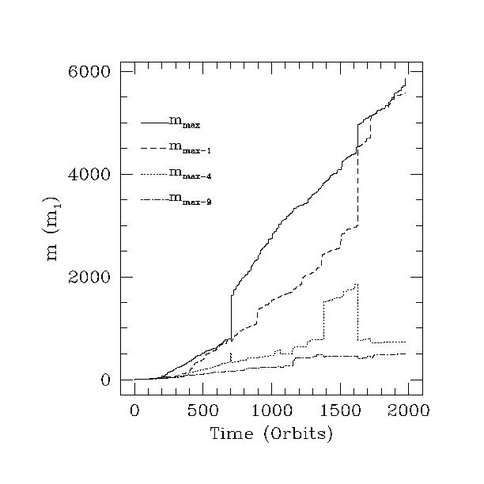2010 Annual Science Report
 VPL at University of Washington
Reporting | SEP 2009 – AUG 2010
VPL at University of Washington
Reporting | SEP 2009 – AUG 2010
Formation of Terrestrial Planets
Project Summary
This past year VPL has continued to explore key unknowns in our understanding of terrestrial planet formation. We have performed supercomputer simulations of the early formation of the Earth, and found that it can proceed more quickly than previously appreciated and suggests terrestrial exoplanets may be common. We also showed how the shape of belts of asteroids in the outer reaches of planetary systems, which can be directly observable, provide clues to the layout of the interior planets, which are often not observable.
Project Progress
This year VPL continued to explore the planet formation process through detailed numerical simulations. Our group covered a diverse range of topics from the early formation of the Earth and Mars to reproducing observed exoplanetary system architecture. These investigations included scientists at all levels of their careers, from college freshman to tenured faculty.
We completed the first simulation of terrestrial planet growth from 1 km planetesimals, often considered the building blocks of terrestrial planets (Barnes et al 2009, see figure). This modeling required hundreds of thousands of hours of supercomputer time using one of the most advanced gravity codes in the world, PKDGRAV. We found that terrestrial planet growth proceeds quickly, which suggests that terrestrial exoplanets with the potential to host life may be common.
We performed simulations of planetary systems with outer belts of comets to explore how the morphology of the outer belts of minor planets are sculpted by the architecture of interior planets (Raymond et al 2010). This investigation showed how planet-planet scattering can reproduce observed trends in properties of the exoplanet population. It also predicts that lower mass planets at larger distances (which have yet to be detected) will have different orbital architectures. These result also predict that the morphologies of outer belts of minor planets, which will be detectable in the near future, may provide information about undetectable planets.
Barnes edited a volume titled Formation and Evolution of Exoplanets, published by Wiley-VCH. Aimed at graduate students, this book provides a comprehensive review of plausible formation scenarios, orbital evolution, and atmospheric dynamics and chemistry.
In addition to the above, we continue to work on numerous outstanding issues.
Raymond and collaborators have made significant headway into the origin of Mars, which most models incorrectly predict to be much more massive. Barnes and collaborators, including undergraduate Adrienne Antonsen, are exploring the origins of the exoplanets Upsilon Andromedae c and d, which have orbital planes inclined by 30 degrees relative to each other. Barnes, Kopparapu and undergraduate Miles Timpe are testing the hypothesis that orbital instabilities produce the observed properties of exoplanets detected by radial velocity. Some of these studies are now published (after Aug. 31), and the rest are nearly completed. In the coming year VPL will continue to make fundamental breakthroughs regarding the origin of planets, and how their formation affects habitability.
Figure caption (1kmGrowth.jpg): Barnes et al. (2009) simulated the
growth and evolution of a swarm of (initially) 1 km
planetesimals. Plotted are the growth rates, relative to the mass of a
1 km planetesimal, with time. The solid line represents the largest
particle, dashed the second largest, dotted fifth largest, and
dot-dashed tenth largest. Given the relatively short timescale, this
work suggests that the Earth can form quickly from an initial
population of small, equal-sized bodies.
Publications
-
Barnes, R., Quinn, T. R., Lissauer, J. J., & Richardson, D. C. (2009). N-Body simulations of growth from 1km planetesimals at 0.4AU. Icarus, 203(2), 626–643. doi:10.1016/j.icarus.2009.03.042
-
Lunine, J. I., O’Brien, D. P., Raymond, S. N., Morbidelli, A., Quinn, T., & Graps, A. L. (2011). Dynamical Models of Terrestrial Planet Formation. Advanced Science Letters, 4(2), 325–338. doi:10.1166/asl.2011.1212
-
Raymond, S. N., Armitage, P. J., & Gorelick, N. (2010). PLANET-PLANET SCATTERING IN PLANETESIMAL DISKS. II. PREDICTIONS FOR OUTER EXTRASOLAR PLANETARY SYSTEMS. The Astrophysical Journal, 711(2), 772–795. doi:10.1088/0004-637x/711/2/772
- Barnes, R. (2010). Formation and Evolution of Exoplanets. Wiley-VCH. Berlin.
- O’Brien, D.P., Walsh, K.J., Morbidelli, A., Raymond, S.N., Mandell, A.M. & Bond, J.C. (2009). Early Giant Planet Migration in the Solar System: Geochemical and Cosmochemical Implications for Terrestrial Planet Formation. American Astronomical Society.
- Spiegel, D.S., Raymond, S., Dressing, C.D., Scharf, C.A., Mitchell, J.L. & Menou, K. (2009). General Milankovitch Cycles. Pathways Towards Habitable Planets. San Francisco: Astronomical Society of the Pacific.
- Walsh, K.J., Morbidelli, A., Raymond, S.N., O’Brien, D.P. & Mandell, A.M. Origin of the Asteroid Belt and Mars’ Small Mass. American Astronomical Society, DPS meeting #42.
-
PROJECT INVESTIGATORS:
-
PROJECT MEMBERS:
Thomas Quinn
Co-Investigator
Ravi Kopparapu
Postdoc
Adrienne Antonsen
Undergraduate Student
Miles Timpe
Undergraduate Student
-
RELATED OBJECTIVES:
Objective 1.1
Formation and evolution of habitable planets.
Objective 1.2
Indirect and direct astronomical observations of extrasolar habitable planets.
Objective 3.1
Sources of prebiotic materials and catalysts
Objective 4.3
Effects of extraterrestrial events upon the biosphere


